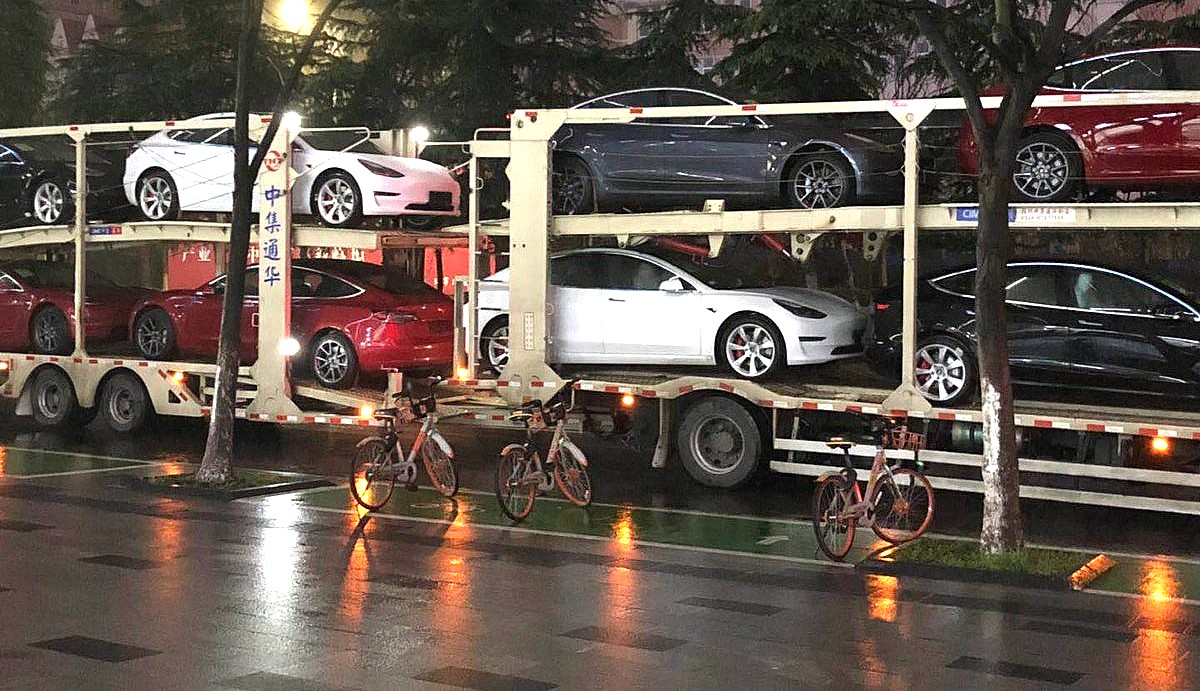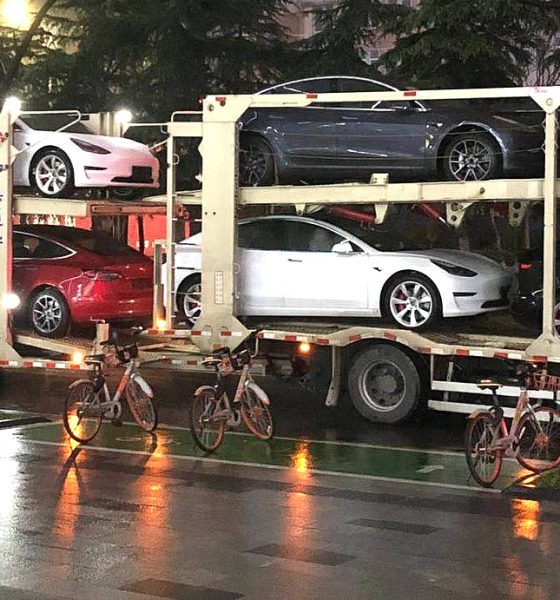

Investor's Corner
Tesla’s owner-volunteers from China mobilize to help end-of-Q2 deliveries
Tesla’s second-quarter deliveries in China are getting a rather unexpected boost, thanks to a number of electric car owners who are volunteering their time to help the company hand over as many vehicles as possible before the end of the month. Tesla is currently attempting to set new delivery records this Q2, and it would take every one of its delivery teams across the globe to dig deep to achieve its goal of beating Q4 2018’s numbers. The fourth quarter, after all, was a time when Tesla delivered more than 90,000 vehicles globally.
Reports from local Model 3 owners in China indicate that several owners have already become more involved in Tesla’s end-of-quarter delivery blitz. Similar to their counterparts in the United States, the Beijing-based Model 3 owners are helping new buyers get familiarized with their new vehicles. Some electric car owners have been doing this in actual delivery centers, while others are doing their part by providing useful information online. One Model 3 owner, who took delivery of his vehicle back in March, has even remarked that the cars coming to China today exhibit improved build quality.
Tesla has a tendency to accelerate deliveries towards the end of a quarter, and this has allowed the company to hit delivery records multiple times in the past. Even in the first quarter, which saw the company deliver significantly fewer vehicles than expected, Elon Musk noted that a good part of the company’s deliveries happened in the last two weeks of March. During a similar time last year, something rather remarkable happened.
Tesla was in a much different situation back in Q3 2018. Model 3 production was finally hitting Musk’s goal of around 5,000 vehicles per week then, and with thousands of cars to deliver every week, Tesla experienced what the CEO described as “delivery logistics hell.” This resulted in some Model 3 deliveries being pushed back multiple times, since Tesla’s delivery teams were, quite simply, overwhelmed. It was at this time when a Tesla owner-enthusiast and Ride the Lightning podcast host Ryan McAffrey suggested that electric car owners could offer some help in handing over vehicles to new owners. Musk loved the idea.
This started what could only be described as a community-powered delivery blitz that saw Tesla owners volunteering their time to help new owners get familiarized with their vehicles. Others even brought food and refreshments for new owners and fellow volunteers. YouTube influencers, longtime Tesla owners, and new Model 3 owners alike all volunteered their time. Together with Tesla executives such as Musk, who also delivered vehicles himself, these initiatives helped the company reach then-record delivery figures, eventually beating Wall St. revenue estimates by posting $6.8 billion in revenue with a GAAP profit of $312 million.
As could be seen in the efforts of Tesla owners in China, this willingness to help the company is not only true for electric car owners in the United States. Even in a place such as China, where the Model 3 only started deliveries earlier this year, owners are volunteering their time to help out the company. This is quite remarkable, and it all but shows the strength of Tesla’s brand. Slowly but surely, and despite the negative narrative surrounding the electric car maker, it appears that Tesla is transitioning from a disruptive electric car company to an idea, or even a movement of sorts. And this could very well be one of Tesla’s biggest strengths today.

Investor's Corner
Tesla stock closes at all-time high on heels of Robotaxi progress

Tesla stock (NASDAQ: TSLA) closed at an all-time high on Tuesday, jumping over 3 percent during the day and finishing at $489.88.
The price beats the previous record close, which was $479.86.
Shares have had a crazy year, dipping more than 40 percent from the start of the year. The stock then started to recover once again around late April, when its price started to climb back up from the low $200 level.
This week, Tesla started to climb toward its highest levels ever, as it was revealed on Sunday that the company was testing driverless Robotaxis in Austin. The spike in value pushed the company’s valuation to $1.63 trillion.
Tesla Robotaxi goes driverless as Musk confirms Safety Monitor removal testing
It is the seventh-most valuable company on the market currently, trailing Nvidia, Apple, Alphabet (Google), Microsoft, Amazon, and Meta.
Shares closed up $14.57 today, up over 3 percent.
The stock has gone through a lot this year, as previously mentioned. Shares tumbled in Q1 due to CEO Elon Musk’s involvement with the Department of Government Efficiency (DOGE), which pulled his attention away from his companies and left a major overhang on their valuations.
However, things started to rebound halfway through the year, and as the government started to phase out the $7,500 tax credit, demand spiked as consumers tried to take advantage of it.
Q3 deliveries were the highest in company history, and Tesla responded to the loss of the tax credit with the launch of the Model 3 and Model Y Standard.
Additionally, analysts have announced high expectations this week for the company on Wall Street as Robotaxi continues to be the focus. With autonomy within Tesla’s sights, things are moving in the direction of Robotaxi being a major catalyst for growth on the Street in the coming year.
Elon Musk
Tesla needs to come through on this one Robotaxi metric, analyst says
“We think the key focus from here will be how fast Tesla can scale driverless operations (including if Tesla’s approach to software/hardware allows it to scale significantly faster than competitors, as the company has argued), and on profitability.”

Tesla needs to come through on this one Robotaxi metric, Mark Delaney of Goldman Sachs says.
Tesla is in the process of rolling out its Robotaxi platform to areas outside of Austin and the California Bay Area. It has plans to launch in five additional cities, including Houston, Dallas, Miami, Las Vegas, and Phoenix.
However, the company’s expansion is not what the focus needs to be, according to Delaney. It’s the speed of deployment.
The analyst said:
“We think the key focus from here will be how fast Tesla can scale driverless operations (including if Tesla’s approach to software/hardware allows it to scale significantly faster than competitors, as the company has argued), and on profitability.”
Profitability will come as the Robotaxi fleet expands. Making that money will be dependent on when Tesla can initiate rides in more areas, giving more customers access to the program.
There are some additional things that the company needs to make happen ahead of the major Robotaxi expansion, one of those things is launching driverless rides in Austin, the first city in which it launched the program.
This week, Tesla started testing driverless Robotaxi rides in Austin, as two different Model Y units were spotted with no occupants, a huge step in the company’s plans for the ride-sharing platform.
Tesla Robotaxi goes driverless as Musk confirms Safety Monitor removal testing
CEO Elon Musk has been hoping to remove Safety Monitors from Robotaxis in Austin for several months, first mentioning the plan to have them out by the end of 2025 in September. He confirmed on Sunday that Tesla had officially removed vehicle occupants and started testing truly unsupervised rides.
Although Safety Monitors in Austin have been sitting in the passenger’s seat, they have still had the ability to override things in case of an emergency. After all, the ultimate goal was safety and avoiding any accidents or injuries.
Goldman Sachs reiterated its ‘Neutral’ rating and its $400 price target. Delaney said, “Tesla is making progress with its autonomous technology,” and recent developments make it evident that this is true.
Investor's Corner
Tesla gets bold Robotaxi prediction from Wall Street firm
Last week, Andrew Percoco took over Tesla analysis for Morgan Stanley from Adam Jonas, who covered the stock for years. Percoco seems to be less optimistic and bullish on Tesla shares, while still being fair and balanced in his analysis.

Tesla (NASDAQ: TSLA) received a bold Robotaxi prediction from Morgan Stanley, which anticipates a dramatic increase in the size of the company’s autonomous ride-hailing suite in the coming years.
Last week, Andrew Percoco took over Tesla analysis for Morgan Stanley from Adam Jonas, who covered the stock for years. Percoco seems to be less optimistic and bullish on Tesla shares, while still being fair and balanced in his analysis.
Percoco dug into the Robotaxi fleet and its expansion in the coming years in his latest note, released on Tuesday. The firm expects Tesla to increase the Robotaxi fleet size to 1,000 vehicles in 2026. However, that’s small-scale compared to what they expect from Tesla in a decade.
Tesla expands Robotaxi app access once again, this time on a global scale
By 2035, Morgan Stanley believes there will be one million Robotaxis on the road across multiple cities, a major jump and a considerable fleet size. We assume this means the fleet of vehicles Tesla will operate internally, and not including passenger-owned vehicles that could be added through software updates.
He also listed three specific catalysts that investors should pay attention to, as these will represent the company being on track to achieve its Robotaxi dreams:
- Opening Robotaxi to the public without a Safety Monitor. Timing is unclear, but it appears that Tesla is getting closer by the day.
- Improvement in safety metrics without the Safety Monitor. Tesla’s ability to improve its safety metrics as it scales miles driven without the Safety Monitor is imperative as it looks to scale in new states and cities in 2026.
- Cybercab start of production, targeted for April 2026. Tesla’s Cybercab is a purpose-built vehicle (no steering wheel or pedals, only two seats) that is expected to be produced through its state-of-the-art unboxed manufacturing process, offering further cost reductions and thus accelerating adoption over time.
Robotaxi stands to be one of Tesla’s most significant revenue contributors, especially as the company plans to continue expanding its ride-hailing service across the world in the coming years.
Its current deployment strategy is controlled and conservative to avoid any drastic and potentially program-ruining incidents.
So far, the program, which is active in Austin and the California Bay Area, has been widely successful.








